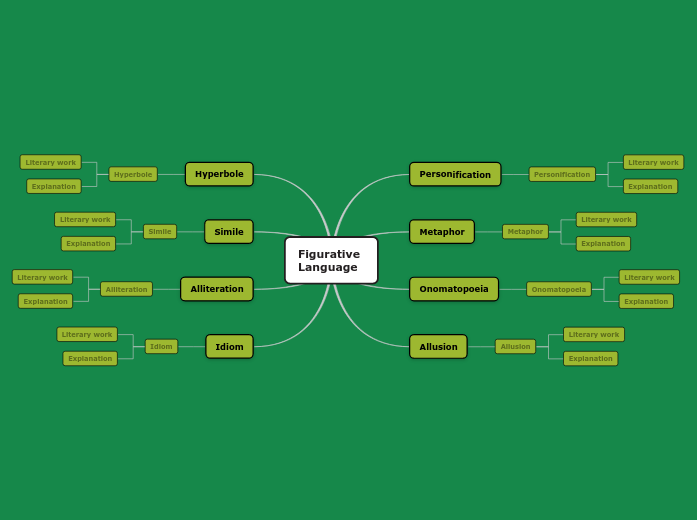Types of Figurative Language
Find figures of speech in your favorite novels and poems.
Keywords: writing, grammar, figurative language


Più simili a questo
This template about figurative language will help you learn about each figure of speech: personification, simile, metaphor, onomatopoeia, allusion, idiom, alliteration, and hyperbole.
You will have to think about a literary work where you find each of them, give an example and explain your choice.
Use this template to learn the figurative language and think about examples for figures of speech so you can better understand each of them.
Find figures of speech in your favorite novels and poems.
Idiom is the figure of speech that uses a combination of words which challenges the conventional usage of those words.
What is the idiom that you found in the novel/poem?
Type it in.
Example: 'a stitch in time saves nine'.
How do you explain your choice? Type in the explanation.
Example:
- A timely effort saves you from much harder work later.
What is the literary work in which you found the idiom? What genre is it?
Example: Pie-IX: A Stitch in Time Saves Nine by Jaida Jones, K.J. Sturgeon - short story.
How do you explain your choice?
Example:
- Almost all the words in the sentence begin with 'th'.
What is the literary work
in which you found the alliteration? Type in the genre.
Example: Thank You for the Thistle by Dorie Thurston - short story.
Simile is a figure of speech that compares two objects through some connective word such as 'like', 'as', 'so', 'than', or a verb such as 'resembles'.
What simile did you find in the novel/poem? Type it in.
Example:
- 'Within the irregular arc of coral the lagoon was still as a mountain lake.'
How do you explain your choice?
Type in the explanation. Example:
- The lagoon is being compared with a mountain lake using the word 'as'.
What is the literary work in which you found the simile?
Is it a novel, short story or poem?
Example: Lord of the flies by William Golding - novel.
The hyperbole is a figure of speech that uses exaggerations to create emphasis or effect.
What hyperbole did you find in the novel/poem? Type it in.
Example:
- 'All that we see or seem / Is but a dream within a dream.'
How do you explain your choice?
Type in the explanation.
Example:
- It is an exaggeration to claim that everything ('all we see or seem') is 'but a dream'.
What is the literary work in which you found the hyperbole? Is it a novel, short story or poem?
Example: A dream within a dream by Edgar Allan Poe - poem.
Allusion is the figure of speech that makes a reference to a well-known person, place, or thing in literature and history.
What is the allusion that you found in the novel/poem? Type it in.
Example:
- 'Like a rich jewel in an Ethiop's ear'.
How do you explain your choice?
Example:
- Shakespeare makes an allusion of the Ethiopian slaves who wore expensive jewelry to express their masters' wealth.
What is the literary work in which you found the allusion? What genre is it?
Example: Romeo and Juliet by William Shakespeare - tragedy
Onomatopoeia is the figure of speech that uses words whose sounds suggest their meanings. Think of words related to water, air, collisions, sounds, voice, etc.
What is the onomatopoeia that you found in the novel/poem? Type it in.
Example:
'The moan of doves in immemorial elms,
And murmuring of innumerable bees...'.
How do you explain your choice?
Example:
'Moan' and 'murmuring' refer to the way doves and bees sound like.
What is the literary work in which you found the onomatopoeia? Is it a novel, short story or poem?
Example: Come Down, O Maid by Alfred Lord Tennyson - poem
Metaphor is a figure of speech that compares two unlike things without using 'like' or 'as'.
What is the metaphor that you found in the novel/poem? Type it in.
Example:
'The rain came down in long knitting needles.'
How do you explain your choice?
Example:
The rain is compared with 'long knitting needles', without the use of 'like' or 'as'.
What is the literary work in which you found the metaphor? Is it a novel, short story or poem?
Example:
National Velvet by Enid Bagnold - novel.
Personification is a figure of speech which gives human qualities to nonhuman things.
Type in the personification you found in the novel/poem.
Example:
'- Not to-night, good Iago: I have very poor and unhappy brains for drinking.'
How do you explain your choice?
Type in the explanation.
Example:
The brain is given the attribute of being 'unhappy'.
What is the literary work in which you found the personification? What is its genre?
Example:
Othello by William Shakespeare - tragedy
Le mappe mentali aiutano a fare brainstorming, a stabilire relazioni tra i concetti, a organizzare e generare idee.
Tuttavia, i modelli di mappe concettuali e mentali vuote offrono un modo più semplice per iniziare, in quanto sono strutture che contengono informazioni su un argomento specifico con istruzioni guida. In sostanza, i modelli di mappe mentali garantiscono la struttura che combina tutti gli elementi di un argomento specifico e servono come punto di partenza per la vostra mappa mentale personale. Sono una risorsa che fornisce una soluzione pratica per creare una mappa mentale su un particolare argomento, sia per il lavoro che per l'istruzione.
Mindomo offre modelli di mappe mentali intelligenti che consentono di lavorare e pensare senza sforzo.
Argomenti descrittivi
Argomenti con testo di sfondo
Ramo predefinito
Rimozione dei dati del modello
È possibile scegliere tra una varietà di modelli di mappe concettuali dagli account aziendali o educativi di Mindomo, oppure creare i propri modelli di mappe mentali da zero. Qualsiasi mappa mentale può essere trasformata in un modello di mappa concettuale aggiungendo ulteriori note guida a uno dei suoi argomenti.